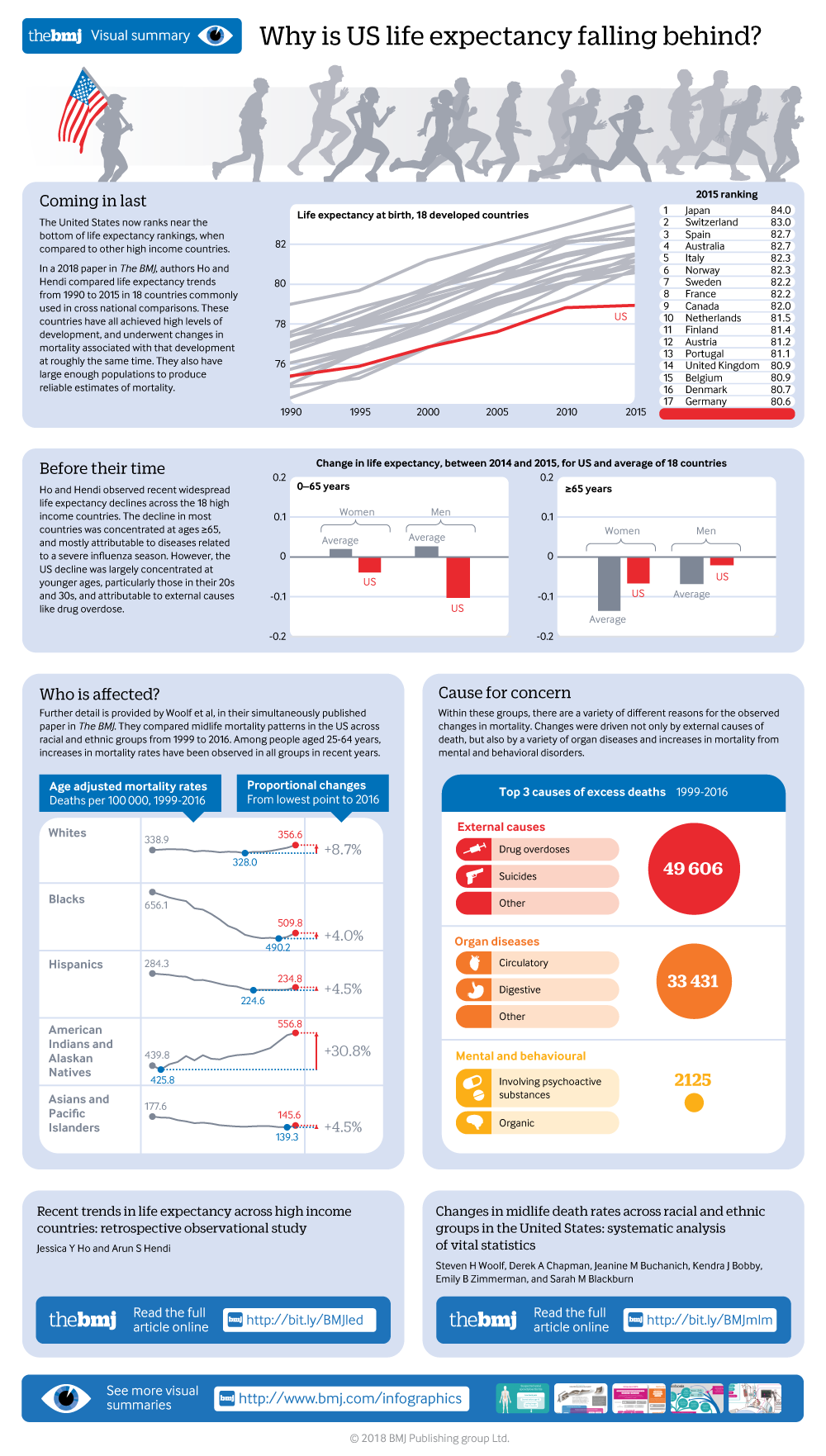Recent trends in life expectancy across high income countries: retrospective observational study
BMJ 2018; 362 doi: https://doi.org/10.1136/bmj.k2562 (Published 15 August 2018) Cite this as: BMJ 2018;362:k2562
Visual summary available
Showing how US life expectancy is lagging behind other rich countries, which citizens are affected, and the causes of death that have risen most sharply in recent years.
Linked editorial
Reversals in life expectancy in high income countries?
- 1Leonard Davis School of Gerontology and Department of Sociology, University of Southern California, 3715 McClintock Avenue, Los Angeles, CA 90089, USA
- 2Office of Population Research and Department of Sociology, Princeton University, Princeton, NJ, USA
- Correspondence to: JY Ho jessicyh{at}usc.edu
- Accepted 4 June 2018
Abstract
Objectives To assess whether declines in life expectancy occurred across high income countries during 2014-16, to identify the causes of death contributing to these declines, and to examine the extent to which these declines were driven by shared or differing factors across countries.
Design Demographic analysis using aggregated data.
Setting Vital statistics systems of 18 member countries of the Organisation for Economic Co-operation and Development.
Participants 18 countries with high quality all cause and cause specific mortality data available in 2014-16.
Main outcome measures Life expectancy at birth, 0-65 years, and 65 or more years and cause of death contributions to changes in life expectancy at birth.
Results The majority of high income countries in the study experienced declines in life expectancy during 2014-15; of the 18 countries, 12 experienced declines in life expectancy among women and 11 experienced declines in life expectancy among men. The average decline was 0.21 years for women and 0.18 years for men. In most countries experiencing declines in life expectancy, these declines were predominantly driven by trends in older age (≥65 years) mortality and in deaths related to respiratory disease, cardiovascular disease, nervous system disease, and mental disorders. In the United States, declines in life expectancy were more concentrated at younger ages (0-65 years), and drug overdose and other external causes of death played important roles in driving these declines.
Conclusions Most of the countries that experienced declines in life expectancy during 2014-15 experienced robust gains in life expectancy during 2015-16 that more than compensated for the declines. However, the United Kingdom and the United States appear to be experiencing stagnating or continued declines in life expectancy, raising questions about future trends in these countries.
Footnotes
Contributors: JH and AH conceived and designed the study. JH acquired the data and drafted the initial manuscript. All authors contributed to analyzing the data, interpreting the results, and revising the manuscript. The corresponding author attests that all listed authors meet authorship criteria and that no others meeting the criteria have been omitted.
Funding: Funding: Principal support for this research was provided by a grant from the Robert Wood Johnson Foundation (No 74439). JH is supported by the Eunice Kennedy Shriver National Institute of Child Health and Human Development of the National Institutes of Health (award No R00HD083519). AH is supported by a pilot grant from the National Institute on Aging of the National Institutes of Health (award No P30AG043073). The content is solely the responsibility of the authors and does not necessarily represent the official views of the National Institutes of Health. The funding sources had no role in study design, data collection, data analysis, data interpretation, writing of the report, or the decision to submit the paper for publication. JH had full access to all the data in the study and had final responsibility for the decision to submit for publication.
Competing interests: All authors have completed the ICMJE uniform disclosure form at www.icmje.org/coi_disclosure.pdf and declare: JH and AH had financial support from the Robert Wood Johnson Foundation, JH had financial support from the National Institute of Child Health and Human Development, and AH had financial support from the National Institute on Aging for the submitted work; no financial relationships with any organizations that might have an interest in the submitted work in the previous three years; no other relationships or activities that could appear to have influenced the submitted work.
Ethical approval: Not required.
Data sharing: The full datasets are publicly available online and can also be requested from the corresponding author.
Transparency: The lead author (JH) affirms that the manuscript is an honest, accurate, and transparent account of the study being reported; that no important aspects of the study have been omitted; and that any discrepancies from the study as originally planned have been explained.
This is an Open Access article distributed in accordance with the Creative Commons Attribution Non Commercial (CC BY-NC 4.0) license, which permits others to distribute, remix, adapt, build upon this work non-commercially, and license their derivative works on different terms, provided the original work is properly cited and the use is non-commercial. See: http://creativecommons.org/licenses/by-nc/4.0/.
